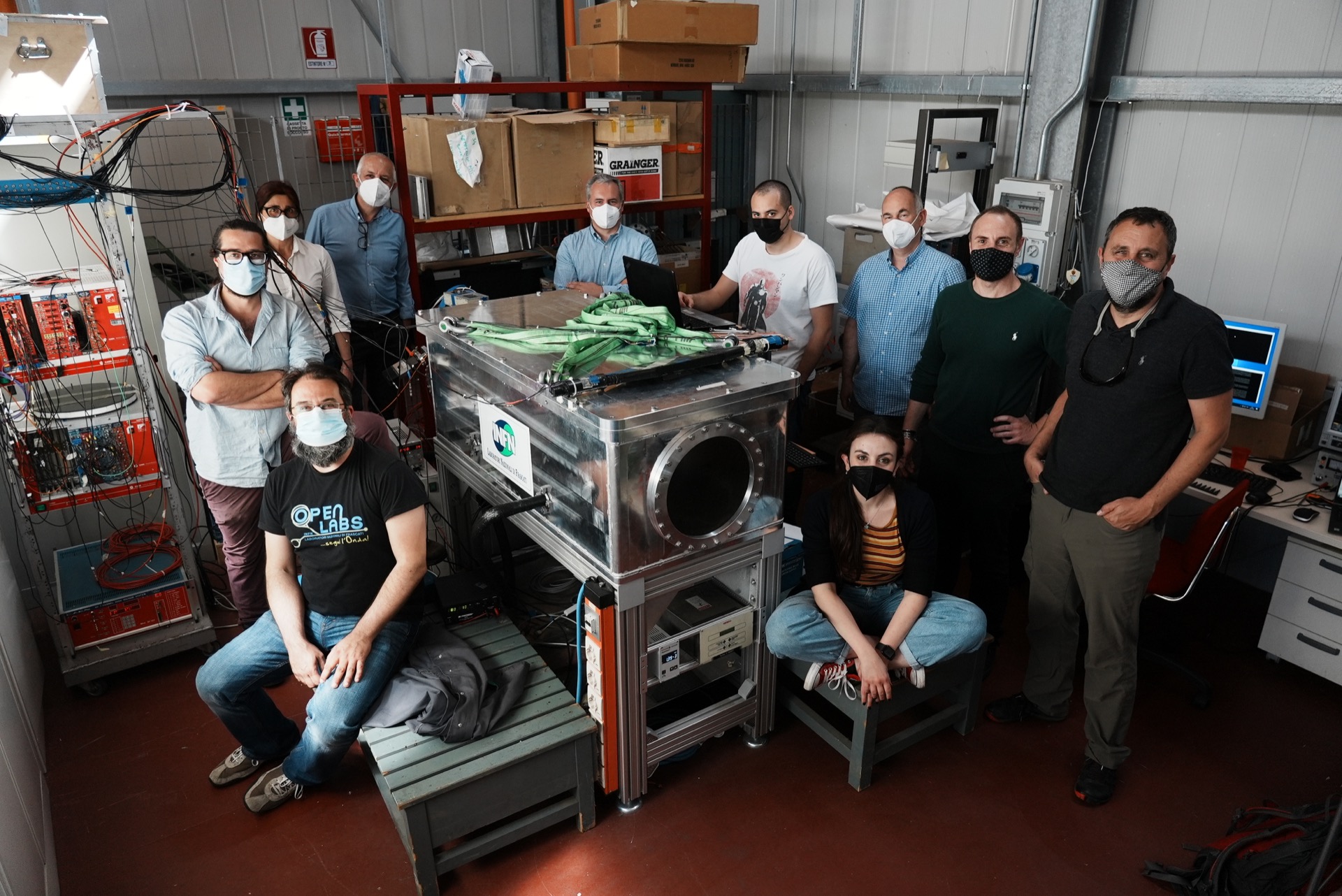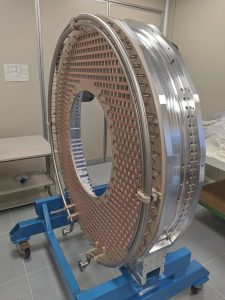 The LNF team together with the colleagues of INFN – Pisa Unit of the Mu2e collaboration, have recently successfully carried out the full test on the final readout electronics of the calorimeter, marking an important milestone for the realization of the experiment.
The LNF team together with the colleagues of INFN – Pisa Unit of the Mu2e collaboration, have recently successfully carried out the full test on the final readout electronics of the calorimeter, marking an important milestone for the realization of the experiment.
Mu2e, in construction at the Fermilab Muon Campus, is an experiment that aims to study the process of direct conversion of a muon into an electron, in presence of an Aluminum nucleus. This process violates the lepton flavor conservation and it is forbidden in Standard Model. The observation of few events would be a clear sign of New Physics. Mu2e has been designed to improve the sensitivity of current experiments by a factor of 10000 and being able to detect this process with a probability up to 10-16, that is equivalent to the probability of having your home destroyed by a meteorite and struck by a lightning bolt in the next 3 months. Several New Physics models foresee this conversion to happen at this probability.
The challenge of the experiment lies in the extreme rarity of the process and it is therefore necessary to produce a large amount of muons, around 1’000’000’000’000’000’000 in three years, number equal to the sand grains of Earth.
The experimental setup is composed by three superconducting solenoid magnets, see figure 1: the Production Solenoid (PS), the Transport Solenoid (TS) and the Detector Solenoid (DS).
The muons are produced by a proton beam, repurposing elements of the Tevatron accelerator complex The proton bunches enter the first solenoid and hit the Tungsten target.
In the interaction between beam particles and target, pions are mainly produced and they in turn decay into muons. The PS magnetic field induce particles to enter the TS. Only one proton over 100 that impinge on the target creates a muon that enters the TS. This solenoid transports the muons up to DS selecting the ones with negative charge and low momentum. The S-shaped TS serves to reduce the number of charged particles that, unlike charges particles, does not follow the two curves.
The detector solenoid hosts the target for muons, that is composed by very thin Aluminum foils. The conversion process can only take place in presence of a nucleus: the 10 billions of muons produced every second are stopped into the target forming muonic atoms (Aluminum atoms with a muon trapped in orbit). In 40% of cases, the muon decays in orbit emitting an electron, a neutrinos and an antineutrinos. In the remaining 60% nuclear muon capture processes leading to a background of protons, photons and neutrons occur. In the rare conversion case, a muon orbiting around an Aluminum nucleus transforms into an electron with a very defined energy equal to muon rest mass.
 The DS magnetic field pushes the charged particles produced in the interaction between beam and target towards the detector system composed by a straw tubes tracker and a crystal electromagnetic calorimeter. After having passed through the tracker, 3 meter long, particles impinge and stopped into the calorimeter where they deposit their energy. This last detector is composed by two rings, each one made of 674 CsI crystals, each crystal is coupled to two Silicon Photomultipliers. The reconstruction of the monoenergetic signal is done by the tracker. Combining the momentum and energy measurements, respectively of tracker and calorimeter, together with the time of flight measurement, one can identify the type of particle and eliminate the contamination due to muons, pions and other particles.
The DS magnetic field pushes the charged particles produced in the interaction between beam and target towards the detector system composed by a straw tubes tracker and a crystal electromagnetic calorimeter. After having passed through the tracker, 3 meter long, particles impinge and stopped into the calorimeter where they deposit their energy. This last detector is composed by two rings, each one made of 674 CsI crystals, each crystal is coupled to two Silicon Photomultipliers. The reconstruction of the monoenergetic signal is done by the tracker. Combining the momentum and energy measurements, respectively of tracker and calorimeter, together with the time of flight measurement, one can identify the type of particle and eliminate the contamination due to muons, pions and other particles.
The Italian Mu2e collaboration is composed by thirty members from LNF and INFN – Pisa, Genova, Trieste and Lecce Units. The Genova group had an important role in the TS construction, the LNF group is covering a leadership role for the electromagnetic calorimeter (Stefano Miscetti is the project manager of the system) working together with the other INFN units and Caltech (US) in the design, prototyping, construction and assembly of the various components.
The calorimeter, characterized by high performance in energy and time resolution, will operate in a hostile environment, in vacuum and with high exposure to radiation and, like in space experiments, without interruptions nor interventions for at least one year.
The LNF-Pisa team has recently successfully carried out the complete test of the entire final readout electronics of the calorimeter (see Picture 1) and in September it will start the installation of the detector in the experimental hall at Fermilab. The same team has started the installation of the mechanical support (see Picture 2) in the ASTRA clean room at LNF.
 INFN-LNF Laboratori Nazionali di Frascati
INFN-LNF Laboratori Nazionali di Frascati
